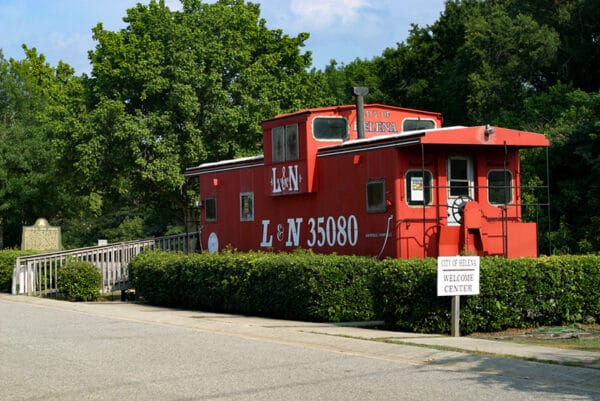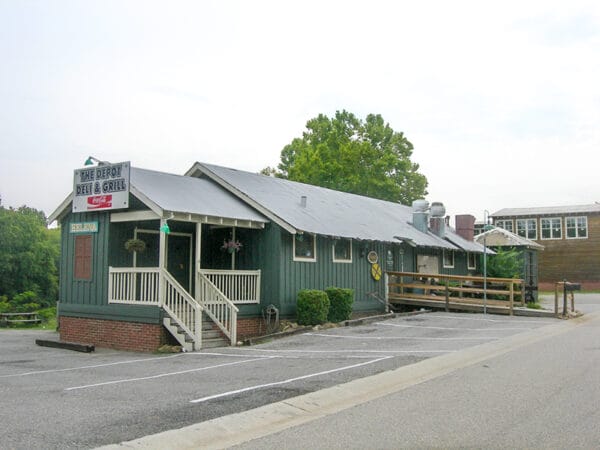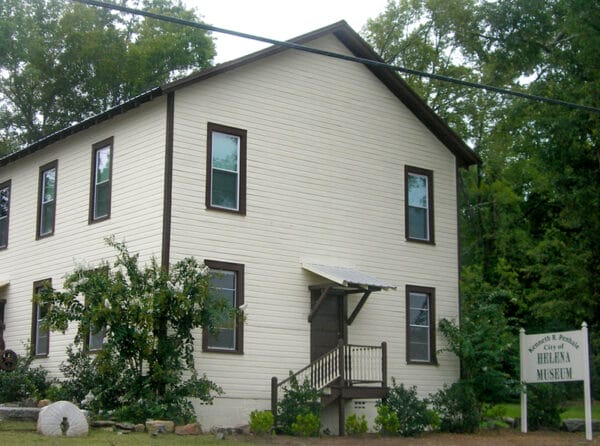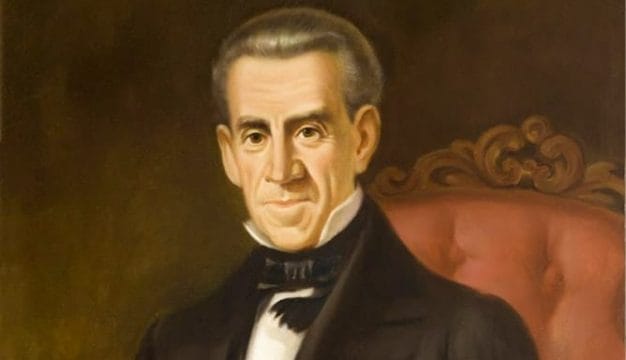Helena
 Helena Welcome Center
Helena is located in both Shelby and Jefferson counties in central Alabama. It has a mayor-city council form of government. Helena is the hometown of the late Broadway star Rebecca Luker and Olympic gold medalist in bobsled Vonetta Flowers.
Helena Welcome Center
Helena is located in both Shelby and Jefferson counties in central Alabama. It has a mayor-city council form of government. Helena is the hometown of the late Broadway star Rebecca Luker and Olympic gold medalist in bobsled Vonetta Flowers.
History
The Helena area was first settled in the mid-1830s. It was known initially as Cove, with a post office being established in 1849; in 1856 the name was changed to Hillsboro. The first buildings in the town were constructed in the 1850s. A spur of the North and South Alabama Railroad was built to serve local coal mines in the 1860s, and a steel rolling mill was built in the area to aid the Confederate war effort. The mill was burned by U.S. Army general James H. Wilson and his forces in March 1865.
During Reconstruction, the Louisville & Nashville Railroad built a depot in the area, purportedly named Helena Station after the fiancée of the engineer who surveyed the land. As the area around the station grew, it absorbed the town of Hillsboro. The rolling mill was rebuilt in 1873, and local coal mines supplied both it and the burgeoning iron and steel industry in Birmingham. Other businesses included a large cotton gin and the railroad yard. Initial incorporation came in 1877, with the first school going up around 1878. The city reincorporated in 1917 after errors were discovered in the initial incorporation papers.
 Helena Freight House & Depot
Helena remained prosperous until the coal mines began to wind down their operations in the late 1910s, and the steel mill, then called Conner Steel, moved to Birmingham. Even more damaging to the town was a massive tornado that hit the city on May 5, 1933, killing 13 and destroying more than 100 dwellings. The city recovered economically and has expanded in the last decades of the twentieth century as the Birmingham metropolitan area’s population has moved primarily to the south into Shelby County.
Helena Freight House & Depot
Helena remained prosperous until the coal mines began to wind down their operations in the late 1910s, and the steel mill, then called Conner Steel, moved to Birmingham. Even more damaging to the town was a massive tornado that hit the city on May 5, 1933, killing 13 and destroying more than 100 dwellings. The city recovered economically and has expanded in the last decades of the twentieth century as the Birmingham metropolitan area’s population has moved primarily to the south into Shelby County.
Demographics
According to 2020 Census estimates, Helena recorded a population of 18,631. Of that number, 73.4 percent identified themselves as white, 17.2 percent as black, 5.0 as two or more races, 4.7 percent as Hispanic, 1.2 percent as Asian, 0.1 percent as Native American, and 0.1 percent as Native Hawaiian and Other Pacific Islander. 2009 census estimates place the town’s median household income as $89,982, and per capita income as $38,686.
Employment
According to 2020 Census estimates, the workforce in Helena was divided among the following industrial categories:
- Educational services, and health care and social assistance (20.6 percent)
- Finance, insurance, and real estate, rental, and leasing (13.2 percent)
- Professional, scientific, management, and administrative and waste management services (12.1 percent)
- Arts, entertainment, recreation, and accommodation and food services (8.6 percent)
- Other services, except public administration (8.2 percent)
- Retail trade (7.7 percent)
- Transportation and warehousing and utilities (7.0 percent)
- Manufacturing (6.1 percent)
- Construction (6.0 percent)
- Public administration (3.3 percent)
- Wholesale trade (3.3 percent)
- Information (2.5 percent)
- Agriculture, forestry, fishing and hunting, and extractive (1.4 percent)
Education
Schools in Helena are part of the Shelby County School District; the town has one elementary school, one intermediate school, and one middle school.
Transportation
Helena is bisected by State Highway 261 and lies just west of both U.S. Highway 31 and Interstate 65. It is connected to both by County Road 58. The closest major airport to Helena is the Birmingham-Shuttlesworth International Airport, approximately 20 miles to the north.
Events and Places of Interest
 City of Helena Museum
The Helena Historic District features many architecturally notable dwellings from the late nineteenth and early twentieth centuries and is listed on the National Register of Historic Places. Helena has a recreation center with basketball courts and one park that features a football field. City-sponsored activities include baseball, softball, basketball, football, and soccer as well as several municipal parks.
City of Helena Museum
The Helena Historic District features many architecturally notable dwellings from the late nineteenth and early twentieth centuries and is listed on the National Register of Historic Places. Helena has a recreation center with basketball courts and one park that features a football field. City-sponsored activities include baseball, softball, basketball, football, and soccer as well as several municipal parks.
The Buck Creek Festival has been held since 2001 on the second weekend of May. The festival has grown from a one-day to a two-day event with an average attendance of 15,000. It features more than 10 musical acts, more than 100 vendors, and a rubber duck race with 2,000-plus participants. Since its inception, the festival has raised more than $140,000 for charity. The city also holds an annual Christmas Parade.
Additional Resources
Shelby County Heritage Book Committee. The Heritage of Shelby County, Alabama. Clanton, Ala.: Heritage Pub. Consultants, 1999.
Taylor, Elba. “History of Helena.” Shelby County Reporter, 6 June 1929. N.p.



